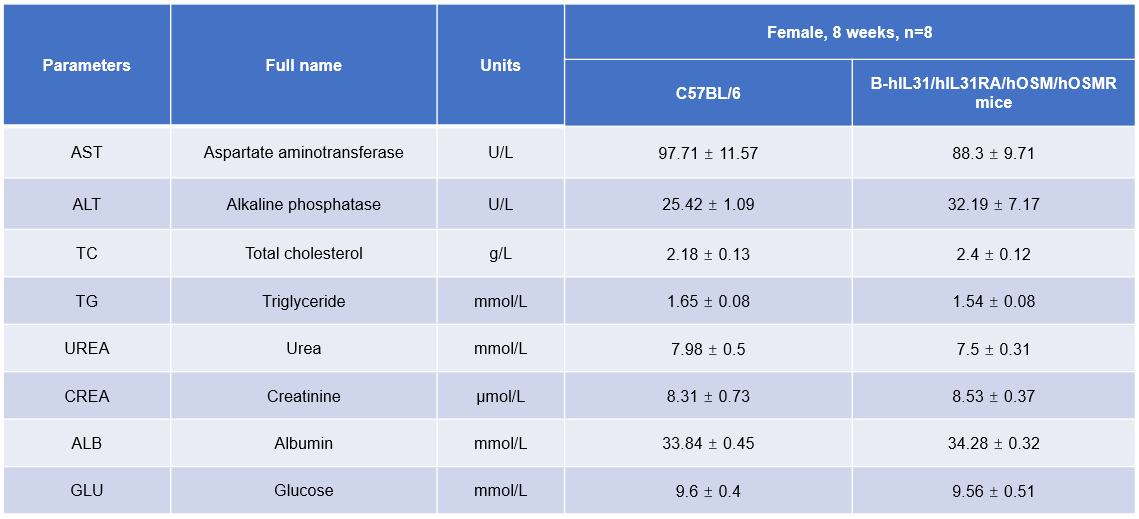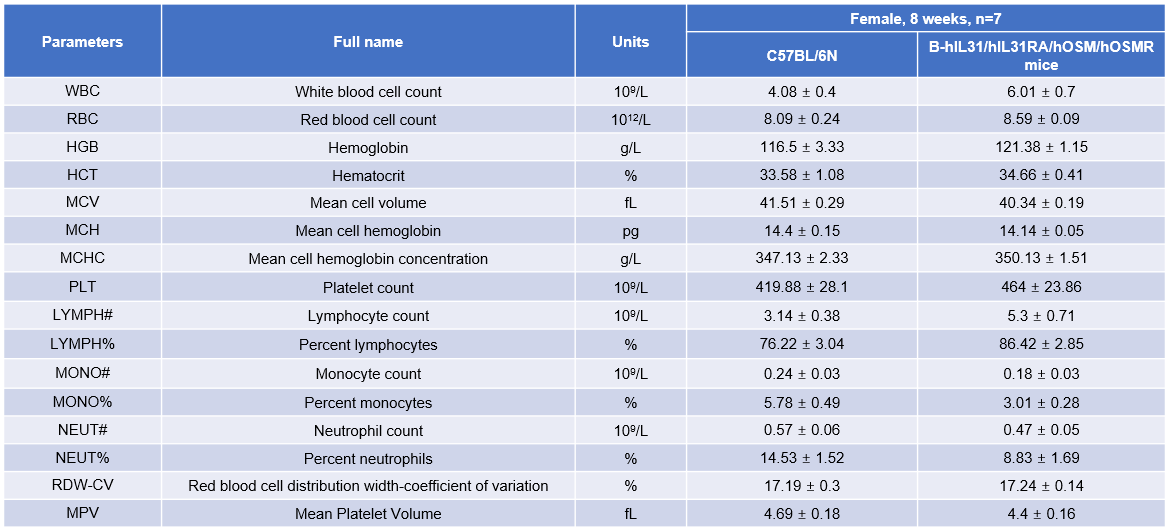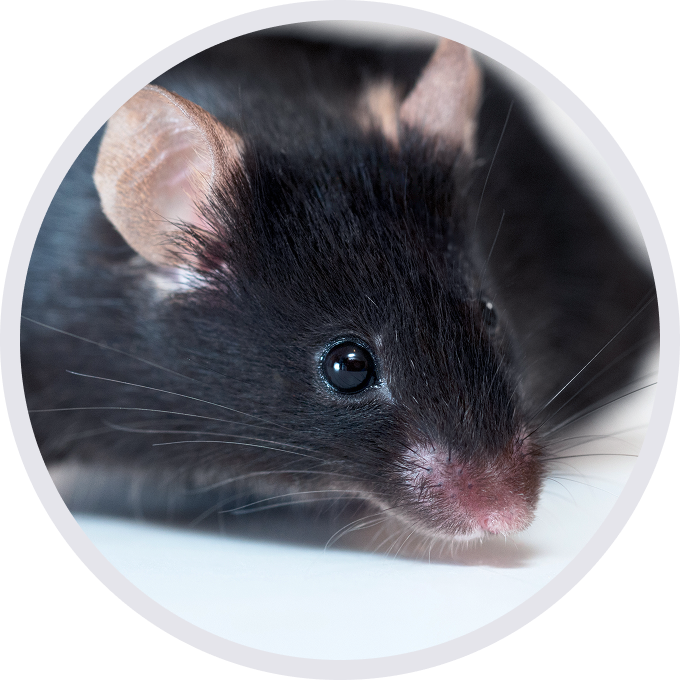
C57BL/6-Il31tm1(IL31)BcgenIl31ratm1(IL31RA)BcgenOsmtm1(OSM)BcgenOsmrtm1(OSMR)Bcgen/Bcgen • 112647

| Product name | B-hIL31/hIL31RA/hOSM/hOSMR mice |
|---|---|
| Catalog number | 112647 |
| Strain name | C57BL/6-Il31tm1(IL31)BcgenIl31ratm1(IL31RA)BcgenOsmtm1(OSM)BcgenOsmrtm1(OSMR)Bcgen/Bcgen |
| Strain background | C57BL/6 |
| NCBI gene ID | 386653,133396,5008,9180 (Human) |
| Aliases | IL-31; CRL; GPL; CRL3; GLMR; GLM-R; PLCA2; hGLM-R; IL-31RA; PRO21384; zcytoR17; OSMRB; PLCA1; IL-31RB; OSMRbeta; IL-31R-beta |
Gene targeting strategy for B-hIL31/hIL31RA/hOSM/hOSMR mice. The mouse Il31 gene that encode the full-length protein was replaced by human IL31 counterpart gene sequences in B-hIL31/hIL31RA/hOSM/hOSMR mice. The mouse Osm gene that encode the full-length protein was replaced by human OSM counterpart gene sequences in B-hIL31/hIL31RA/hOSM/hOSMR mice. The coding sequences including human IL31RA extracellular region and mouse Il31ra intracellular region were inserted into mouse IL31RA gene in B-hIL31/hIL31RA/hOSM/hOSMR mice. The coding sequences including human OSMR extracellular region and mouse Osmr intracellular region were inserted into mouse Osmr gene in B-hIL31/hIL31RA/hOSM/hOSMR mice.

Strain specific analysis of IL31 and IL31RA gene expression in wild-type C57BL/6 mice and homozygous B-hIL31/hIL31RA mice by RT-PCR. Testis was collected from wild-type mice (+/+) and B-hIL31/hIL31RA mice (H/H). Mouse Il31 and Il31ra mRNA were exclusively detectable in wild-type mice. Human IL31 and IL31RA mRNA were exclusively detectable in homozygous B-hIL31/hIL31RA mice, but not in wild-type mice.
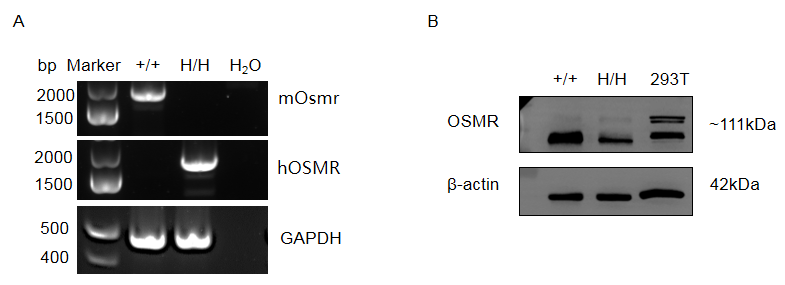
Strain specific analysis of OSMR gene expression in wild-type mice and B-hOSM/hOSMR mice. Kidney was collected from wild-type C57BL/6 mice (+/+) and homozygous B-hOSM/hOSMR mice (H/H), and analyzed by RT-PCR and western blot. (A) mRNA expression. Mouse Osmr mRNA was exclusively detectable in wild-type mice. Human OSMR mRNA was exclusively detectable in homozygous B-hOSM/hOSMR mice. (B) Protein expression. The OSMR protein were detected both in wild-type mice and homozygous B-hOSM/hOSMR mice. 293T cells were used as positive control.

Strain specific OSM expression analysis in homozygous B-hOSM/hOSMR mice by ELISA. Spleen were isolated from wild-type C57BL/6 mice (+/+) and homozygous B-hOSM/hOSMR mice (H/H), and stimulated with anti-mouse CD3 and anti-mouse CD28 antibodies in vitro. Cell culture supernatants were collected and analyzed by species-specific OSM ELISA kit. Mouse OSM was detectable in wild-type mice. Human OSM was exclusively detectable in homozygous B-hOSM/hOSMR mice but not in wild-type mice.

hOSM induced IL-6 secretion is blockade by anti-hOSMR antibody in MEFs of homozygous B-hOSM/hOSMR mice. Mouse embryonic fibroblasts (MEFs) were derived from either C57BL/6 mice or B-hOSM/hOSMR mice, and stimulated with different concentrations of mOSM (0-100 ng/mL) or hOSM (0-1000 ng/mL) for 24h. Supernatants from each well were collected and analyzed for IL-6 expression by ELISA. (A) In the MEFs of C57BL/6 mice, IL-6 can be induced by mOSM in a dose-dependent manner, but not by hOSM. It demonstrates that hOSM can’t be recognized by mouse receptor. (B) In the MEFs of B-hOSM/hOSMR mice, hOSM can induce IL-6 secretion, and the function can be blocked by anti-hOSMR antibodies (in house). Cells were incubated with antibodies (10 μg/mL) for 30 minutes, and stimulated with hOSM. The results show that the OSMR signaling function was not influenced by gene humanization.
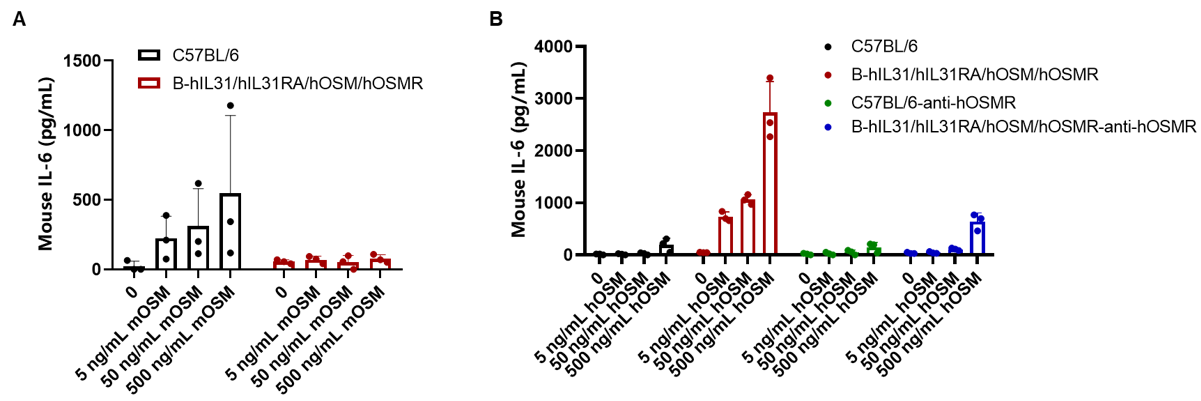
OSM-induced IL-6 is reduced by anti-hOSMR antibody in homozygous B-hIL31/hIL31RA/hOSM/hOSMR mice. Lung fibroblasts derived from either C57BL/6 mice or B-hIL31/hIL31RA/hOSM/hOSMR mice were plated at 15,000 cells/well in 96-well plates and stimulated with indicated concentrations of mOSM or hOSM (0-500 ng/mL) for 24 h, then cell culture supernatants were collected for ELISA analysis of IL-6. (A) rmOSM induced IL-6 expression in wild-type C57BL/6 mice with dose-dependent manner, but not in homozygous mice. (B) rhOSM induced IL-6 expression in homozygous mice with dose-dependent manner, but not in wild-type mice. Meanwhile, the secretion of IL6 can be blocked by anti-hOSMR antibodies (in house).
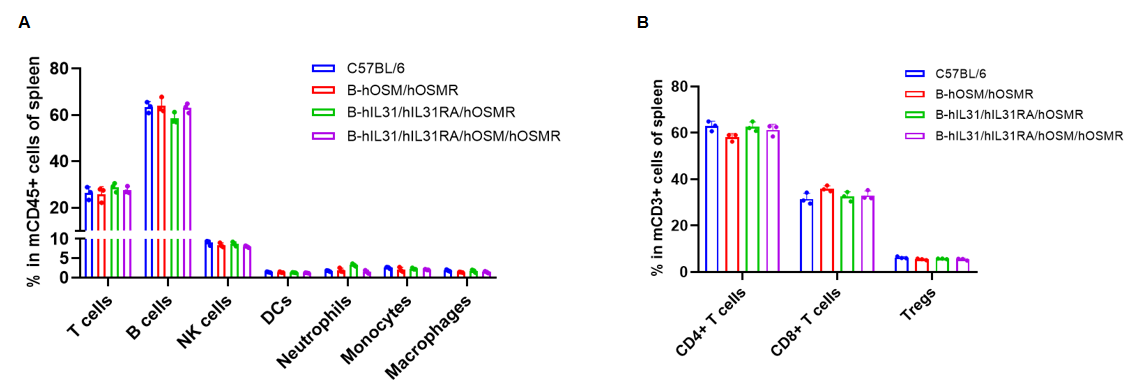
Analysis of spleen leukocyte subpopulations by flow cytometry. Splenocytes were isolated from C57BL/6, B-hOSM/hOSMR mice, B-hIL31/hIL31RA/hOSMR mice and B-hIL31/hIL31RA/hOSM/hOSMR mice (n=3, 6 or 7-week-old, female, homozygous). Flow cytometry analysis of the splenocytes was performed to assess leukocyte subpopulations. (A) Spleen leukocyte subpopulations. (B) T cells subpopulations. Percent of T cells (CD8+ T cells, CD4+ T cells, and Tregs), B cells, NK cells, dendritic cells, neutrophils, macrophages and monocytes in B-hOSM/hOSMR mice, B-hIL31/hIL31RA/hOSMR mice and B-hIL31/hIL31RA/hOSM/hOSMR mice were similar to those in the C57BL/6 mice. Data was shown as mean ± SD, and analyzed using Ordinary one-way ANOVA method. (*p<0.05)

Analysis of blood leukocyte subpopulations by flow cytometry. Blood cells were isolated from C57BL/6, B-hOSM/hOSMR mice, B-hIL31/hIL31RA/hOSMR mice and B-hIL31/hIL31RA/hOSM/hOSMR mice (n=3, 6 or 7-week-old, female, homozygous). Flow cytometry analysis of the blood was performed to assess leukocyte subpopulations. (A) Blood leukocyte subpopulations. (B) T cells subpopulations. Percent of T cells (CD8+ T cells, CD4+ T cells, and Tregs), B cells, NK cells, dendritic cells, neutrophils, macrophages and monocytes in B-hOSM/hOSMR mice, B-hIL31/hIL31RA/hOSMR mice and B-hIL31/hIL31RA/hOSM/hOSMR mice were similar to those in the C57BL/6 mice. Data was shown as mean ± SD, and analyzed using Ordinary one-way ANOVA method. (*p<0.05)

Analysis of lymph node leukocyte subpopulations by flow cytometry. Lymph node cells were isolated from C57BL/6, B-hOSM/hOSMR mice, B-hIL31/hIL31RA/hOSMR mice and B-hIL31/hIL31RA/hOSM/hOSMR mice (n=3, 6 or 7-week-old, female, homozygous). Flow cytometry analysis of the lymph node was performed to assess leukocyte subpopulations. (A) Lymph node leukocyte subpopulations. (B) T cells subpopulations. Percent of T cells (CD8+ T cells, CD4+ T cells, and Tregs), B cells and NK cells in B-hOSM/hOSMR mice, B-hIL31/hIL31RA/hOSMR mice and B-hIL31/hIL31RA/hOSM/hOSMR mice were similar to those in the C57BL/6 mice. Data was shown as mean ± SD, and analyzed using Ordinary one-way ANOVA method. (*p<0.05)
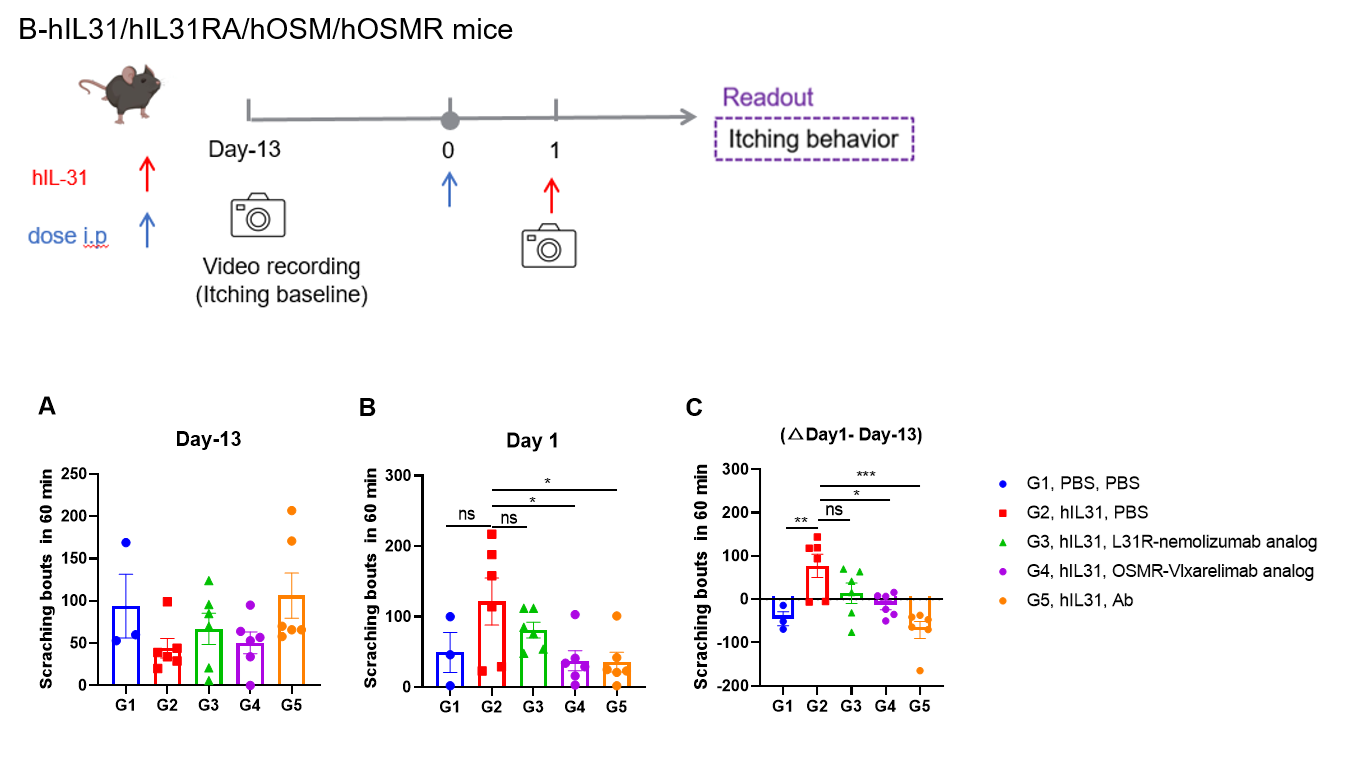
Anti-hOSMR antibodies attenuate the scratching behaviors in IL31-induced murine pruritus model. Human IL31 was administered to the B-hIL31/hIL31RA/hOSM/hOSMR mice (female, 15-week-old, 6 mice/group) to induce the scratching behaviors. Meanwhile, the mice were treated with nemolizumab analog, Vlxarelimab analog and Ab or PBS(Nemolizumab analog, Vlxarelimab analog and Ab provided by client). Scratching behavior was recorded on day -13 (A), day 1 (B).Summary of the mouse Itching frequency in different groups shown in figure (C). As shown in figure C, IL31-treated mice show significantly increased scratching bouts. In the Vlxarelimab analog and Ab treatment group, blockade of IL-31 signaling with anti-hOSMR antibodies and Ab significantly attenuates scratching behaviors on day 1. Values are expressed as mean ± SEM. Significance was determined by the two way ANOVA. (*P < 0.05, **P < 0.01, ***P < 0.0001, ns: not significant).
